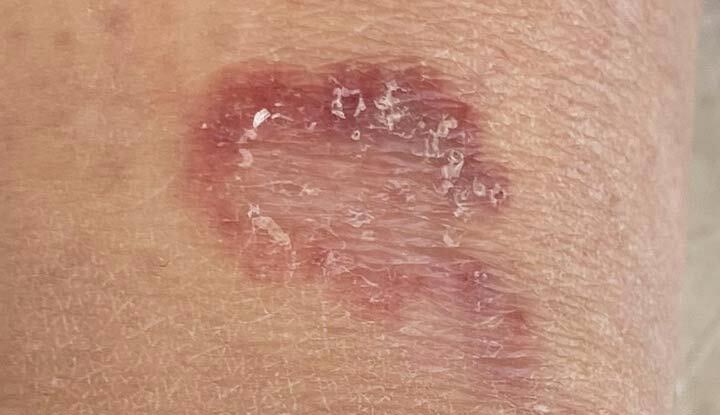Granuloma annulare is a long-lasting skin disorder that most commonly affects children and young adults. Symptoms include a raised, discolored rash or lumps under your skin. Treatments include medications and therapy.
Advertisement
Cleveland Clinic is a non-profit academic medical center. Advertising on our site helps support our mission. We do not endorse non-Cleveland Clinic products or services. Policy

Granuloma annulare is a benign (not harmful), often chronic (long-lasting) skin disorder. Inflammation in your skin causes a raised, discolored rash or lumps under your skin. In most cases, rashes form on your hands, feet, forearms and elbows.
Advertisement
Cleveland Clinic is a non-profit academic medical center. Advertising on our site helps support our mission. We do not endorse non-Cleveland Clinic products or services. Policy
There are five main types of granuloma annulare. It’s possible to develop more than one type of granuloma annulare at the same time.
Granuloma annulare most commonly affects children and young adults, though it may affect people of all ages. It affects women twice as much as men.
You may be more likely to have granuloma annulare if you have diabetes, especially Type 1 insulin-dependent diabetes.
You may also be more likely to have granuloma annulare if you have a thyroid disease, including thyroiditis, hypothyroidism and thyroid adenoma.
If a healthcare provider diagnoses you with granuloma annulare — particularly generalized granuloma annulare — ask them if screening for other conditions sometimes seen in people with granuloma annulare is right for you.
Advertisement
Perforating granuloma annulare is more common in Hawaii.
In skin of color, you may have dark areas of skin (hyperpigmentation) once the inflammation goes away.
Chronic granuloma annulare can also affect your emotions. It can affect you psychosocially (how society and social groups affect your thoughts and emotions) and psychologically (how you think about yourself and your behavior). You may experience stress, anxiety and depression.
Granuloma annulare symptoms vary according to what type you have.
Symptoms of localized granuloma annulare include:
Symptoms of generalized granuloma annulare include:
Symptoms of subcutaneous granuloma annulare include:
Symptoms of perforating granuloma annulare include:
Symptoms of patch granuloma annulare include:
Healthcare providers and medical researchers don’t know the exact cause of granuloma annulare. Some research suggests that your immune system might have an inappropriate response to an injury to your skin.
Healthcare providers and medical researchers also think the following may trigger granuloma annulare:
Some people develop granuloma annulare after exposure to environmental triggers, like being out in the sun for a long time.
Some research suggests that chronic stress may cause granuloma annulare. Reducing your stress may help prevent granuloma annulare. Try the following tips to help reduce your stress:
No, granuloma annulare isn’t contagious. You can’t spread granuloma annulare to another person through skin-to-skin contact.
Advertisement
A healthcare provider will perform a physical examination of your skin.
After a physical examination, they may perform a skin biopsy to confirm their diagnosis. They’ll remove a small sample of your skin. Then, they’ll send the skin sample to a laboratory so other healthcare providers can examine it under a microscope to help determine what’s causing your rash.
For most people, granuloma annulare goes away on its own without treatment. It usually disappears completely within two years. However, in some people, the rash can come back later.
If granuloma annulare causes large areas of rash on your skin or deep, large lumps under your skin, your healthcare provider may recommend treatment.
The purpose of treatment is to help control itching or pain. Treatments may speed up the time it takes for your rash to fade.
Treatment options include:
Advertisement
For some people, granuloma annulare is challenging to treat. You may need to try several therapies before finding what works best for you.
Changes to your diet may help improve granuloma annulare. Some studies suggest that restricting the amount of lipids (cholesterol and triglycerides) in your diet may cause granuloma annulare to disappear faster. This may also be true if you have diabetes, elevated lipids in your blood or other conditions that healthcare providers sometimes see in people with granuloma annulare.
There’s very little research on whether home remedies can help treat granuloma annulare. However, proper skin care can help improve your skin’s overall health.
The following can help improve your skin’s overall health:
For most people, granuloma annulare clears up on its own without treatment, and it doesn’t leave any scars or traces behind.
However, granuloma annulare is a chronic disease. Lesions often return, and rashes often return in the same place. If your lesions or rashes come back, they usually disappear faster than when they first appeared.
Advertisement
There isn’t any way to prevent granuloma annulare.
Granuloma annulare is a skin condition that causes a raised, discolored rash or bumps to develop on your skin. Healthcare providers don’t know the exact cause of granuloma annulare. Your immune system may play a role in the development of this condition. You can’t spread granuloma annulare to another person through skin-to-skin contact.
Ringworm is a skin condition that causes an itchy, discolored, ring-shaped rash to form. A fungus causes ringworm — it’s not actually a worm. It’s highly contagious. You can pick up ringworm through direct contact with an infected person or animal or a contaminated surface, like a locker room floor or sweaty gym clothes. Ringworm tends to be scalier than granuloma annulare.
Granuloma annulare is an annoying skin condition that can make you feel self-conscious. However, it’s common and very normal, and it usually goes away on its own within two years. It’s a good idea to pay attention to your skin. If you have any questions, your healthcare provider is there to help.
As your child grows, you need healthcare providers by your side to guide you through each step. Cleveland Clinic Children’s is there with care you can trust.

Last reviewed on 11/15/2022.
Learn more about the Health Library and our editorial process.